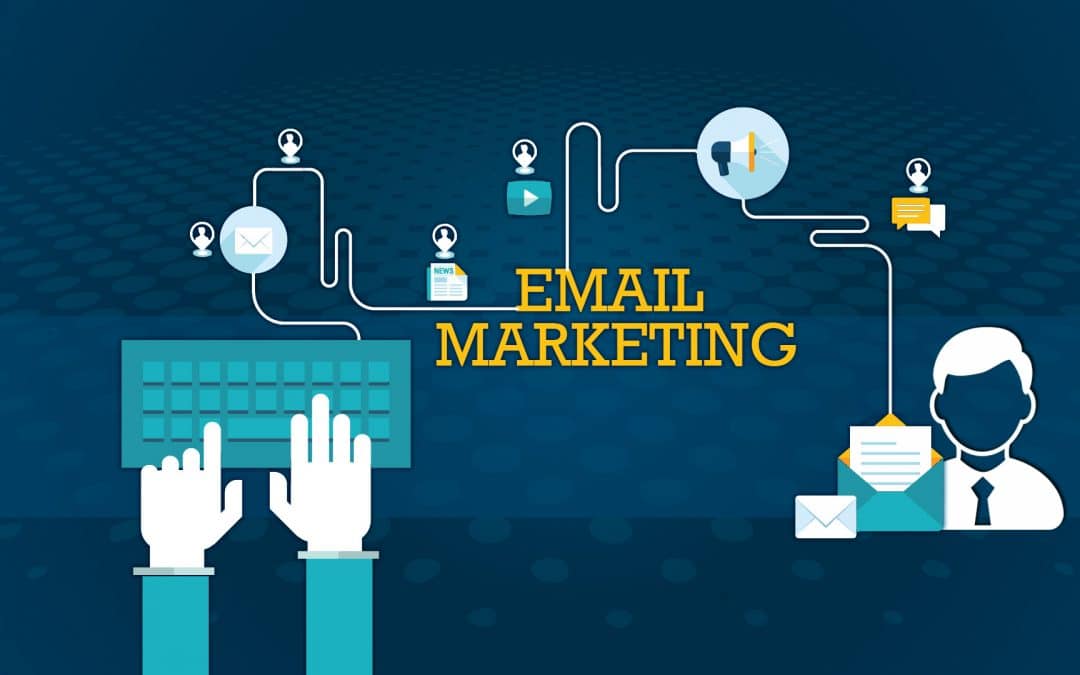When it comes to lead generation, the days of solely relying on cold calling are over. A one-size-fits-all sales pitch probably won’t cut it in today’s competitive marketplace. If you’re sending out the same sales template and just replacing the name of a potential lead, it’s time to make a change.
Rather than reaching out to prospective leads with just cold calls or an overeager pitch, sales teams have discovered that inbound lead generation and personalized outbound techniques are more effective. Having a potential customer seek you and/or your business out is known as inbound lead generation. So how can you bring in these potential leads? Email marketing, blogging, social media, networking and providing online content that’s accurate, engaging and informative are all avenues that will attract customers.
-
Implement email marketing
Email marketing is one of the few outbound lead generation techniques that still holds a great amount of influence. As a salesperson, you need to do an ample amount of research to see who would be genuinely interested in your service or product. Using emails from your existing customer list is a great start. Once you have a foundation, you can then research people or businesses that relate to your existing customers. When you send your email marketing campaigns to people who would legitimately benefit from your service, it’ll increase your chances of landing a lead that will convert.
A strong call to action is one of the most important things to include in an email marketing campaign – and yet many salespeople forget to include one. There needs to be a way for email recipients to engage with you and your product or service. Adding that clear directive, in addition to having an attention-grabbing subject line, will help your email stand out in your prospect’s inbox. Then, once they open the email, your content should be creative and engaging to keep their attention.
Email Marketing Checklist
Now that you’ve expanded your email recipient list, there are a few things to remember when reaching out to a prospective lead.
- Who are you really contacting? Even if you have an expansive email list, it’s important to choose the right person to contact. If you’re sending your email marketing message to a general email address, there’s a chance it will never be read by the people who actually have the power to purchase your service or product. Make sure to send your email campaigns to a specific person.
- Time your emails: Monday often brings a flooded inbox. Research shows that sending your emails on Tuesday, Wednesday and Thursday can result in higher open rates. Set yourself apart from the competition by sending your email later in the week.
- Quantity is important: One of the quickest ways to get your emails sent to the spam folder is being too aggressive with the number you send. Monitor the frequency and number of emails you send so that you’re not turning off a lead before they even read your email.
-
Embrace your company’s blog
You don’t have to be the next Huffington Post, but having a blog on your brand’s website will increase traffic and garner more potential leads. For example, if your company offers a B2B software product, posting blogs on a regular basis about B2B topics will attract consumers who are already interested in or searching for what you’re selling. Having a blog will also build your credibility and authority among readers.
Having a regularly updated blog offers more chances for valuable keywords to be found on your website. This could help improve your ranking with Google searches, making your brand more visible to potential leads. While some business websites try to overstuff keywords on their web pages, having a blog that offers valuable information is far more beneficial for improving your search presence.
Blogging Checklist
- Topics: Your blog topics should be relatable to your company as well as your respective industry. If you run a marketing company, it doesn’t make sense for you to write about politics. Create blog posts that relate to your expertise.
- Audience: It’s important to know your audience. If your readers are millennials, it can help to shift your language and point of view to better relate to millennial topics of interests while using slang. Similarly, if your readers are seniors, you may have to adapt your language to that age group.
- Post frequency: If not many people are checking into your blog, it’s not a smart tactic to continue posting twice a week. It may be more beneficial for you to post bi-weekly and garner increased views for a smaller amount of posts.
-
Make social media your best friend
In this age of millennials, social media is king when it comes to advertising and connecting with consumers. Posting on social media sites such as Facebook, Twitter and LinkedIn is one of the easiest ways to reach potential leads. The key to doing social media well is sharing a consistent number of posts that offer variety.
Posting about your company’s special offers, announcing new blog posts and sharing articles related to your industry provide diverse and interesting content for your followers. Similar to blog posts, social media posts should have a call to action when possible so your potential customers can easily purchase or learn more about your products. Remember, social media is designed to be engaging. Be active on these platforms and interact with users as much as possible – especially in response to your customer’s comments.
Social Media Checklist
- Choose the right channel: Depending on your company and customers, posting on Facebook can have a far better outcome than using Twitter – or vice versa. Identify your existing social channels and see which medium has the most interaction. Then, focus more of your efforts on that one social media channel.
- Respond to followers: Social media is a fantastic way to interact with your customers. If a customer comments on your posts, whether it’s positive or negative, be sure to reply to that comment. This will also signal to your followers that you really do read comments and care about customer feedback.
- Offer a variety of content: While it is exciting to see special offers on social media, you don’t want to see the same post over and over again. Diversify your posts. Try experimenting with posting industry articles, special events you may be hosting and real-time achievements of your brand.
-
Meet new people
Networking will never go out of style. As powerful as social media is, nothing can truly replace an authentic person-to-person connection. Attend networking events in your area and seek out business groups or associations to join. Don’t lose hope if you don’t end up with a long list of leads. Forming new relationships can open up the chance for secondary and tertiary connections. You never know when one of these connections could benefit your business in the future.
Hosting an event such as a conference or a lecture is another great way to attract new leads. You are already presenting to a group of people that has a solid interest in your field, so it creates a pool of people to pitch to. Presentations are also a great chance to meet people in your industry, learn from each other and research the current climate of your general market.
Networking Tips
- Check your body language: Having an open and friendly demeanor can be the difference between meeting people or leaving a networking event with the same number of business cards you arrived with – none. Body language can instantly attract people. Start with a smile, and be open to leading or listening in conversations.
- Bring a buddy: If the idea of networking terrifies you, try bringing a friend or colleague with you to your next networking soiree. This will make you feel more at ease and also help increase your total number of connections.
- Be timely in your follow-up: Remember to follow up with your networking contacts. If you promised to send an email, then remember to send it promptly. If you wait too long, your contact could end up forgetting who you are entirely.
-
Maximize your content
Ever go to a business’s website, read through several pages and still don’t understand exactly what it offers? Unfortunately, this is the case for many businesses that neglect their website – the prime source of information for their brand. Offering well-written, understandable and relatable content on your website is one of the primary ways to generate new leads.
To truly maximize your content, be sure to add calls to action throughout your website. Include options for your potential customers to join an email list, learn more about a service and purchase a product with ease. Your website should also be easy to navigate. If potential leads click on a social media icon or email marketing link for a specific offer but then end up on the wrong page, they may not want to take the extra time to find what they were looking for. Make sure that links for landing pages coincide with the actual deal in discussion.
Website content provides an opportunity to guide users to the pages and information that you want them to see. Make sure that every piece of content has a purpose and flows seamlessly with the rest of the pages. This creates a smooth user experience in addition to an effective sales funnel for your company.
Content Tips
- Organization: Having an easily navigable website is crucial. You don’t want your potential leads to have to dig for your contact information or basic details about your offers. Make sure each of your pages is well-organized and clearly labeled.
- Create easy templates: Your templates, the ones that ask for more information, encourage you to sign up for a product or set up an appointment, should be simple. Steer away from asking for excessive amounts of information because that can lead to abandonment of your page.
- Add calls to action: Make it easy for your customers to purchase your product or service. Provide multiple opportunities by adding calls to action across multiple pages on your website.
-
Experiment with outsourcing lead generation
Even when utilizing various techniques such as email marketing, blogging, and social media, it can be difficult finding new leads. If you’re still struggling with lead generation, try outsourcing to professionals who are more adept at finding potential clients. These experts will have years of experience and existing connections that you can benefit from.
Outsourcing can also save your business money by cutting down on costs for data analysis, reducing the need for a large sales team and decreasing time spent pursuing leads. Some of the top lead generation companies include LeadGeneration.com, RainKing, Callbox, Netline, Candorworks, and Strategic Sales and Marketing.
Outsourcing Tips
- Discuss costs: Be upfront about costs. If that’s your main influencer in choosing your lead generation company, than it’s OK to make that known. This will also open up the conversation to tailoring your service. It’s also important to figure out your total costs just in case there are any hidden fees involved.
- Make sure they listen to your needs: If the lead generation company you choose fails to listen to your concerns or fails to offer a solution to any of your apprehensions, that could be a red flag. You don’t want to end up partnering with a company that is inflexible or doesn’t really care about your concerns.
- View their existing clients: A good marker of a successful lead generation company is its client list. Chances are, if a company’s customer list includes major corporations and Fortune 500 companies, then it’s a trustworthy business that succeeds in generating leads.
Visit the Crunchbase Blog for More on Sales Strategies>
How Crunchbase can help
With the sheer volume of information available, it can sometimes feel overwhelming just researching potential leads for your company. Using Crunchbase Pro can make it easier to find possible investors AND customers. Our database has a multitude of filters, so you can customize searches to suit your company’s needs.
We also offer valuable information on myriad companies and their recent investments and funding. This can benefit you because it can show which business will be more likely to invest in your offering. Getting to know about a company’s current financial health can help you prepare for the optimal time to pursue leads. Utilizing Crunchbase Pro in conjunction with the five inbound and outbound techniques can help you not just generate leads but find much more qualified leads that are far more likely to purchase a product or service from your business.













